"Power walking is better than sex."
— Me
🎉 How Lucky For You!
You've just landed on a blog post where I'll introduce you to the absolute META of fitness exercises. The top of the heap. The cream of the crop. The safest, most efficient, life-changing workout you've never heard of.
Walking. With. Weights.
It's true what they say: "Life is really simple, but we insist on making it complicated".
Find out how the simple act of walking with hand weights can greatly benefit your physical and mental health (with video tutorials by yours truly!)
What IS Walking?
I bet you never considered walking something worth contemplating.
Walking is what humans evolved to do over the span of hundreds of thousands of years. It's the most optimized type of movement the human body can do. Walking, just as standing upright, are so important for survival, we can do them without any conscious thought: our brains actually developed separate areas, specialized at maintaining our sense of balance, Cerebellum being the prime example. That is how important walking is.
However, "unconscious" control over walking is mostly possible only when no extra load is present on the body. That's because the added weight usually noticeably changes the center of gravity of the combined system.

The good news is that the body and the brain are highly pliable and adaptable. If we keep walking with something moderately heavy regularly, over time we'll get more used to such movement, whereas letting go of the load would make previous weight-free movement easier.
So… If we walk all the time… What if we deliberately introduce challenge to this very activity with the goal of making ordinary walking effortless, and improve our fitness along the way?
That's the idea I'd like to share with you, along with the expected results and explanations, in the hopes that you'll find this activity as compelling and inspiring as I did.
Steve Reeves' Legacy
This whole ordeal started after I came across a short documentary on a certain bodybuilder, where power walking was mentioned as something Mr. Reeves was promoting in his later years:
Turns out, it was this very Steve Reeves who was crowned the 1950 Mr. Universe and played the role of Hercules in the 1958 film by the same Title.
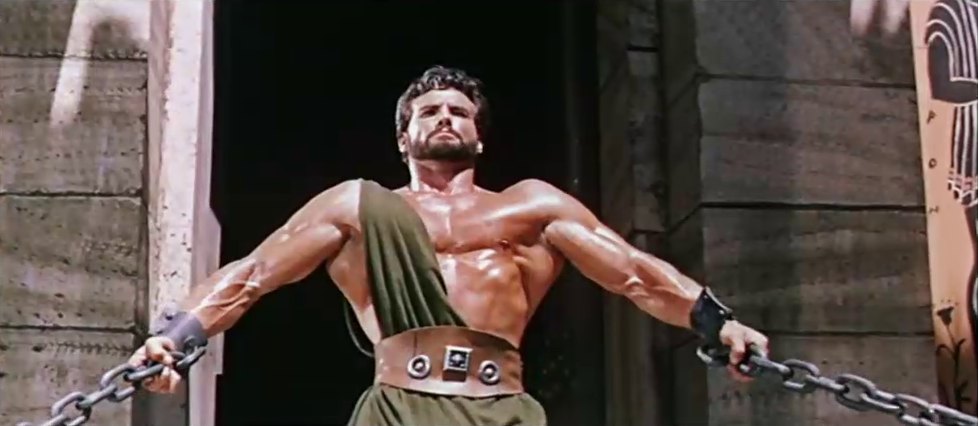
While researching his biography, I also discovered that he was considered one of the last "natural" bodybuilders striving to improve his physique without the help of performance-enhancing drugs, the use of which boomed when the anabolic effects of growth hormone and steroid injections became widely known.
This is how the 21-year-old Reeves looked shortly before winning the 1947 Mr. America competition:
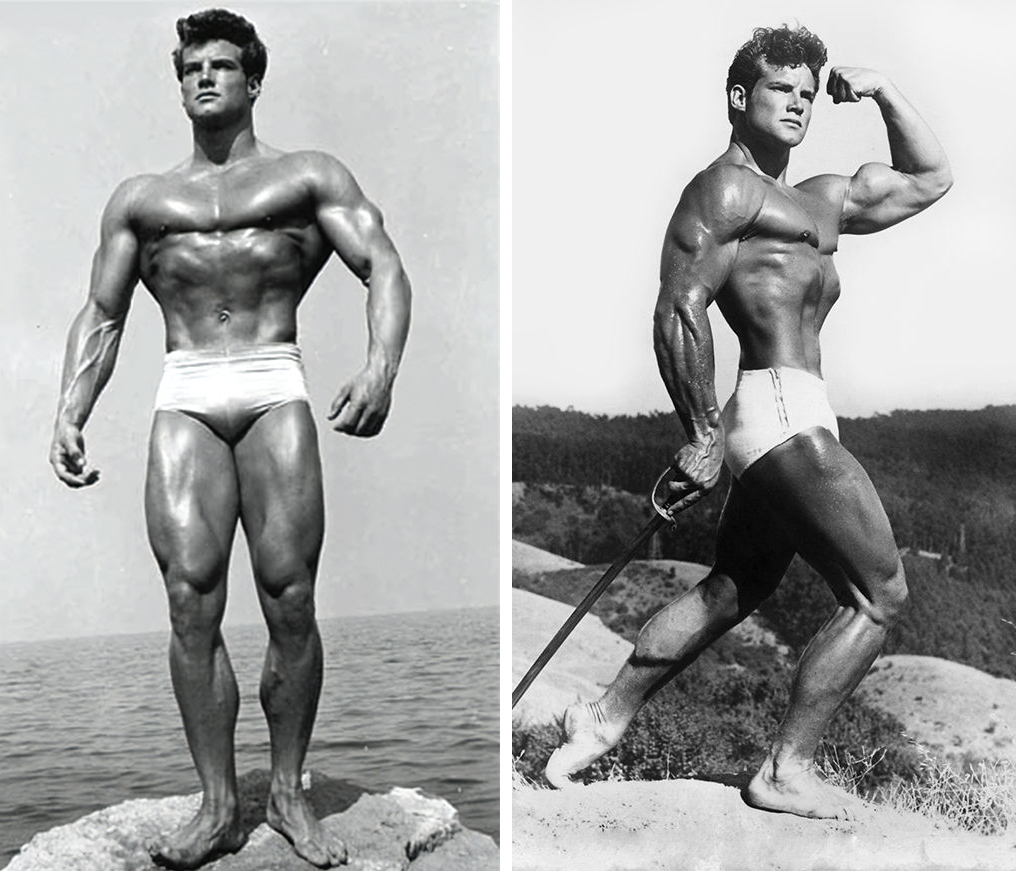
Of course, only Steve himself really knew if any chemicals played a role in helping him achieve this impressive physique. But judging from the photos and the overall well-proportioned shape of his body, without the wildly prominent features often seen in today's chemically-assisted bodybuilders, I would believe that Mr. Reeves either didn't use much of the stuff or avoided it altogether. His physique strongly resembles that of the "strongmen of old" when meat, eggs and dairy were the only known "supplements" for muscle growth.
Anyway, what matters is that this man had a lot of experience in the field of bodybuilding and decided to share his thoughts in the form of several published books later in life. And one of those just happened to be "Powerwalking", published in 1982.
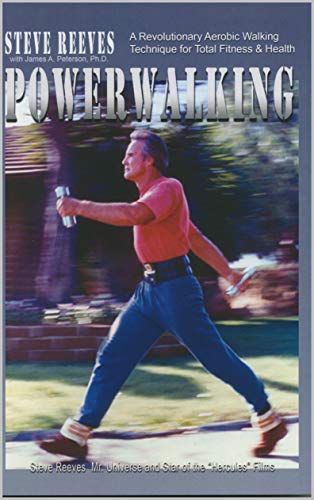
When he was in his 50's and prioritized fitness, Reeves wanted to popularize power walking as a form of rapid jaunt performed with long strides and pendulum-like arm swings, ideally while holding light dumbbells. Steve would go on such moderate-intensity walks throughout the year and believed that the surge of interest in power walking in the U.S. in the 1980s was solely his achievement.
If you're interested in the book, I recommend "borrowing" (yes, that's what they call it) the book here for an hour or more, depending on how you wish to check it out. If you can only get access to it for an hour, be sure to read pages 24-41 thoroughly in the allotted time, as Mr. Reeves is a much more credible source than I could ever be on this topic, and much of what I'm talking about in this post comes after going through the original.
Walking Is Better Than Running!
A bold and controversial statement, right?
Please trust me when I say this: walking and power walking are vastly better than running, since for the same amount of calories you burn, you avoid the negative side effects of running. And I know what I'm talking about. As someone with over 5 years in athletics, specifically in speed skating/roller skating, with daily running and strength training, 3 times a day, with hundreds of kilometers of distance covered over the years as formal training, I can vouch, that any form of running (jogging included) puts a lot more destructive stress on the knees and ankles compared to any form of walking. And — surprise-surprise — feet and knee joints are insanely complex and highly prone to wear and injury, so you absolutely want to avoid over-exerting both if you wish to have a healthy and productive retirement. Find out more:
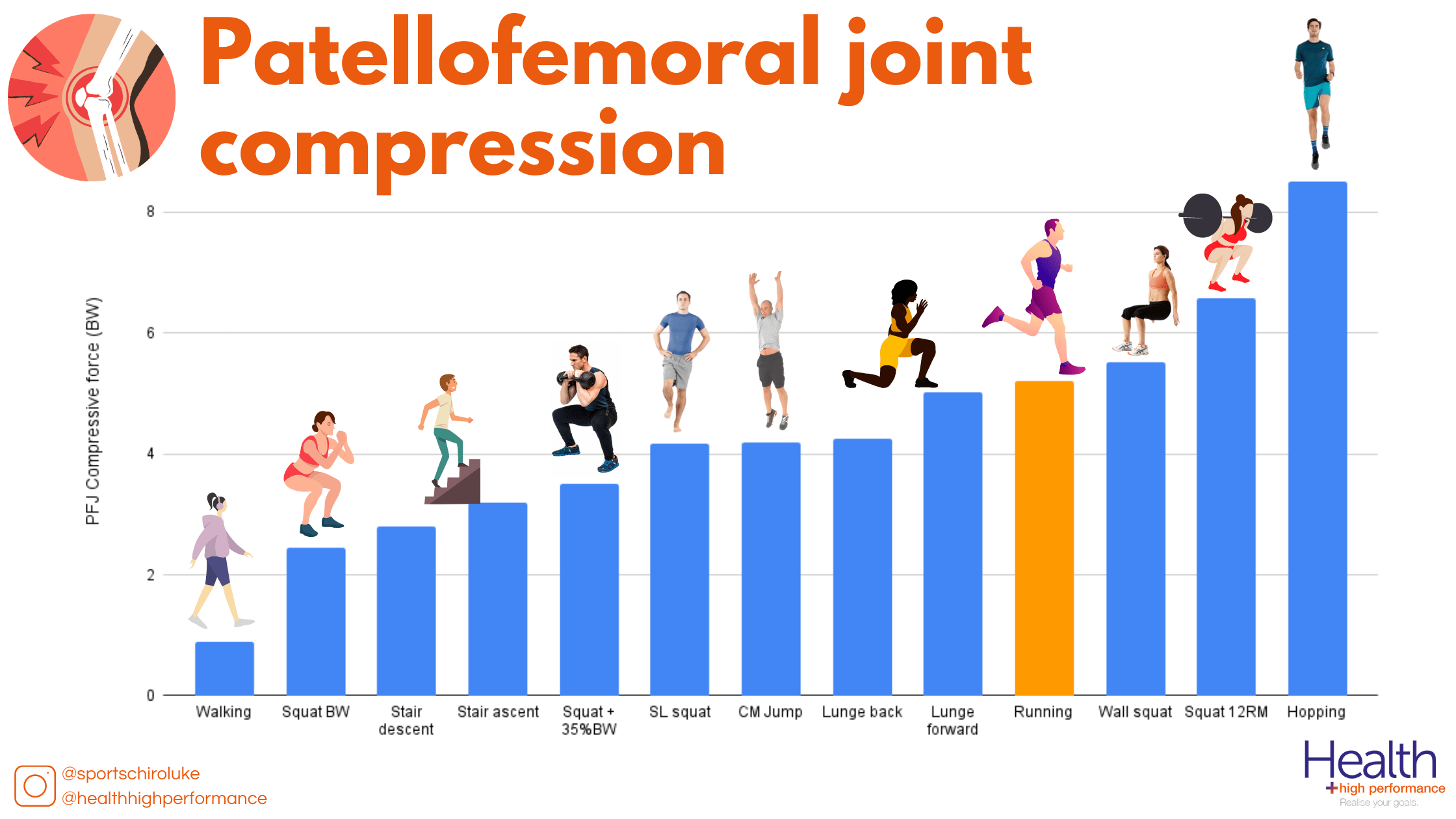
It's up to you to agree with me or not, but there's a plethora of better ways to strengthen your joints, rather than repeatedly slamming them against the ground or, God forbid — hard pavement or asphalt, for extended periods of time. And walking is among those better exercises.
Power walking, as a more demanding variation of walking, comes with health benefits, similar to running or jogging:
- improves cardiovascular health. More muscles are engaged due to a longer stride and more energy is expended due to more steps made per minute. Moderately increased heart rate helps avoid heart diseases and other chronic illnesses;
- Since joints are engaged in a safer exercise routine, this can help avoid joint injuries and improve the health of your bones as well;
Even a simple act of walking is an effective, low-impact, low-risk exercise. Yes, an exercise. The fact that most of us don't consider walking anything special is only thanks to how amazing the human body is, as well as how well it's built for this very type of terrain traversal.
Power Walking ≠ Race Walking
Power Walking has nothing to do with Race Walking! These are completely different types of movement with different goals and techniques, Race Walking being much more difficult to master. Race Walking has its roots in competitive sports as a long-distance discipline within the sport of athletics, whereas power walking is a general fitness workout. In this post, we'll focus on the latter, which I hope will become a staple of your regular fitness routine.
"Just Walking" VS Power Walking
Some basic biomechanical terminology before we proceed:
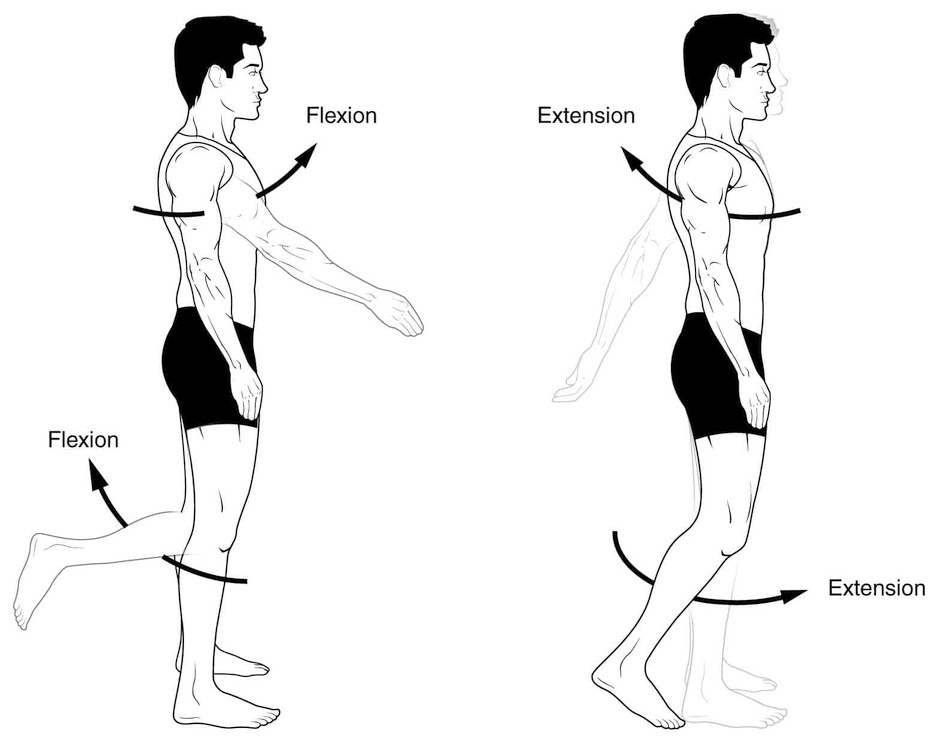
It's important to understand the key differences between walking and power walking.
Walking:
- short stride length
- lower flexion/extension of the arms
- done at a leisurely or moderate pace
Weight-free or "classic" power walking:
- longer stride length
- higher flexion/extension of the arms
- preferably done at a brisk pace
Power Walking With Weights
Power Walking With Weights (or "PWWW") is a more challenging form of power walking, with the following characteristics:
- variable stride length
- moderate to high flexion/extension of the arms
- preferably done at a brisk pace
- weights on the arms and/or in hands
The benefits of PWWW, specifically, go beyond just fitness. Being actually challenging to the muscles due to the added weights, PWWW requires contraction of more slow-twitching fibers, compared to explosive stress experienced during strength training and power-lifting, which involves more fast-twitching fibers. And guess what? The number of fast-twitching fibers decreases as you age! So with proper and regular practice of PWWW you will get reasonable slow-twitching fiber muscle gains all around the body, and these fibers will be the ones to stay with you the longest!
Therefore, I argue that PWWW is a perfect all-round workout for all ages. The sooner you make it a part of your life, the more advantage you'll have over your peers quality of life-wise, when aging becomes a significant factor.
To Powerwalk or to Powerwalk?
If you're new to power walking, I advise against using any weights during your first several walks.
It's vital to get a firm grasp at what a basic powerwalk feels like, because later, when you grab those hand weights, you will note just how much they can affect your balance, especially if they're over 2 kg (4.4 lb) each. To properly compensate for a larger momentum, a good reference is paramount. That being a well-practiced weight-free powerwalk. Remember: practice doesn't make perfect, it makes permanent. Do yourself a favor and teach your body a proper power walking technique before upping the challenge, to avoid frustration and decreased effectiveness of the whole endeavor.
I should also note, that Steve Reeves recommends not going over 5 pounds (~2.3kg) per arm:
"My next phase was walking up hills, and then mountains, until I got in such shape that the mountains felt like hills and the hills felt like I was on the level. So then I thought, "Well, I've got to add weight to my body," and so I started adding ankle weights and waist weights and hand weights. I worked up from 1 pound in each hand to ten pounds in each hand - but ten was too heavy, it interfered with my stride. So I broke it down to 5 pounds and I've found that's the best. A person shouldn't walk with more than 20% of their bodyweight; 10% around the waist, and the rest pided between the wrist and the ankle weights".
The reasoning being: "…ten [pounds] was too heavy, it interfered with my stride".
Keep in mind that Steve Reeves became a proponent of power walking in his 50s. At that age, you're not really looking for a significant amount of muscle growth and/or ways to put a noticeable amount of stress on your body. The logical goal in Mr. Reeves' case was to find a light workout that would complement his daily routine and add some extra activity. Hence the chosen limit on the weights to be used during powerwalks.
Nowhere near as authoritative as Mr. Reeves, I would recommend the following changes to the "classic" routine, as long as you are younger than 50 or in such excellent shape that you want to continue improving your physique:
- One might want to go over 5 pounds per arm because it requires more effort to maintain body balance, which is what we want to strengthen the body further than what's possible with more "leisurely" walks
- Ankle weights should be avoided, because effectiveness of adding weights to lower body is highly questionable and even likely to cause injury and serious walking imbalance issues. This is relevant regardless of age, for it's just a not a good idea to use ankle weights at all when walking, ever
Therefore, before you decide to go with my version of power walking, please do consider whether you should trust my recommendation or stick to Mr. Reeves' guidelines, based on what kind of results you are looking for or which age group you're in. Personally, I will continue to walk with my chosen weights in the meantime, as I have not yet reached the 50-year milestone.
These Weights Are Made for Walking
Almost anything can be used as weights as long as you can grab and hold it. Even so, I recommend purchasing small "fitness" hand weights, for they are very inexpensive, and available in a variety of shapes and sizes.

Since I am fairly fit thanks to a healthy exercise regimen (as well as a certain fitness videogame), I started with two 1.5 kg (3.3 lb) weights, and found out that those were way too light for my abilities. So after a week of using those as means to getting used to this type of an exercise, I purchased two compact 5 kg (11 lb) dumbbells. And the first walk with those… Let me tell you… It was a challenge! How much of a challenge? A single 3 km (1.9 miles) powerwalk required a whole week of recovery due to muscles getting sore all over the body, except the joints — those were just fine. After a full recovery, I felt incredibly energized and eager for more! That was the moment I realized I "struck gold" and discovered a fun all-round exercise to stick to for the years to come, and simply had to share my experience in the blog.
5 weeks or 12 powerwalks later I felt like I confidently grew out of those 5 kg weights and went a bit further by increasing those to 6.5 kg (14.3 lb) per arm:
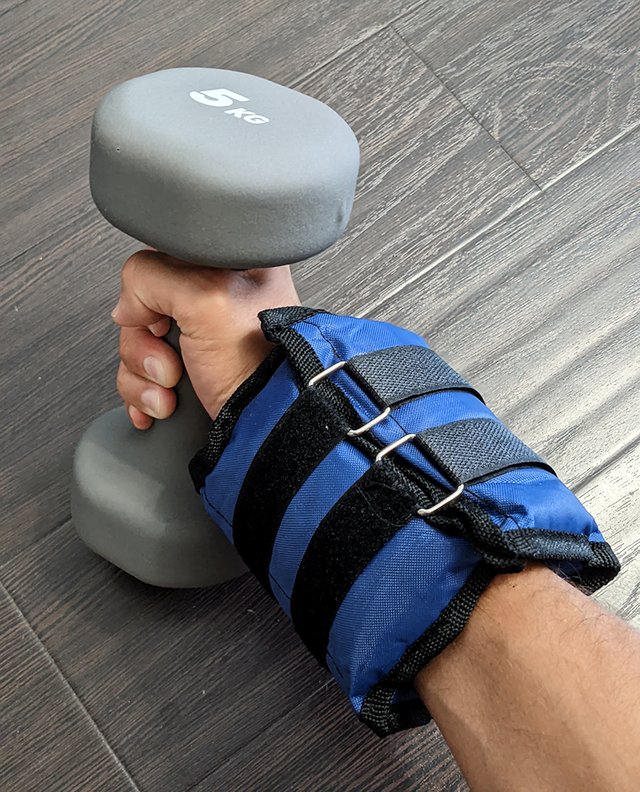
As you can see, to reach 6.5 kg per arm without having to carry bulkier and less convenient dumbbells, I got myself a couple of wrist weights, 1.5 kg (3.3 lb) each. They can be larger or smaller, depending on your ability:

Still, as of September, 2023, I dialed the weights back to 5 kg per arm, which feels like a good balance: I both enjoy my powerwalks and get quite a bit of an exercise with each one. It's important to avoid over-exerting yourself, because the harder it gets, the less incentive you might have to come back to these workouts (for they are not just "walks" anymore). I think I'll stick with these weights after all.
Don't overdo it!

Remember: life is about balancing things out. You can't give everything 100% all the time. Power walking, just like fitness in general, is something that should result in excitement and progressive quality of life improvements, not suffering for the sake of achieving results at any cost. Also, because they have completely different goals, fitness programs are the opposite of traditional strength training. If you're looking to "bulk up" a lot, look elsewhere.
...And a Word of Caution
If you choose to use moderately heavy weights, make sure that you don't do more than 2 powerwalks per week. Also (and this is important!) be sure to balance this upper body training with lower body workouts!
These can include squats, leg raises, "mountain climbs", etc. This is important because it's the glutes that are used most when walking normally, and adding weights to the upper body puts more of the load on the upper back muscles. But it's both upper and lower muscle groups that need to do work, otherwise your lower back may not be able to properly support the tighter upper back muscles. Which can lead to lower back pain.
So power walking is not meant to replace all exercises types! It's just yet another workout that focuses heavily on the upper body.
Get Yourself Ready!
Before the Powerwalk
- Get hydrated. To avoid having to carry a bottle or flask of water, it's easier to drink enough water half an hour before the walk. If you're sufficiently hydrated, you can easily do without additional water intake during your 30-60-minute powerwalks
- Warm up. Spend at least 10 minutes stretching from top to bottom. Pay special attention to your upper body and upper and lower back stretches to avoid injury. Remember, this is not a "walk in the park," it's a workout with weights. Weights that put noticeable stress on the muscles that stabilize the body
Equipment
- Dumbbells (with wrist weights if needed). I recommend getting weights, which are covered with vinyl or neoprene to make them easier to grip and hold without the hands blistering or the weights slipping
- A headband to keep the sweat off your brow. You will sweat a lot during powerwalks, and having dumbbells in your hands makes it inconvenient to swipe the sweat regularly
- Comfortable sneakers or running shoes. Power walking is, well… walking. Everything that makes walking comfortable or otherwise will only get amplified during your power walks. Make sure to pick the most convenient footwear, not too springy, not too stiff — it should feel just right©
Frequency
I powerwalk 2 times a week. Recovery depends on the intensity, so whenever I spend more time doing power sprints during powerwalks, I naturally tend to require longer recovery. Depending on your ability you might want to start with just 1 power walking session a week and go from there. Avoid exercising with sore muscles: it doesn't feel good and will only increase your recovery duration.
Time and Distance
A single powerwalk for me is about 3-3.5 km (1.9-2.2 miles), with a "personal best" of 6 km in a single session. One should take care not to overdo it, especially in the beginning. Aim for a session of between 30 and 60 minutes. Any longer and you run the risk of overloading your joints (shoulders in particular) and ending up feeling lousy and annoyed instead of feeling the deep sense of accomplishment and excitement.
If you wish to accurately track your progress, a phone app, smart watch with GPS or some other device with a GPS module should do the trick and help track your routes and overall progress. If you choose to go with a phone, you can slip it into a pocket or use some sort of a running armband if you're feeling fancy.
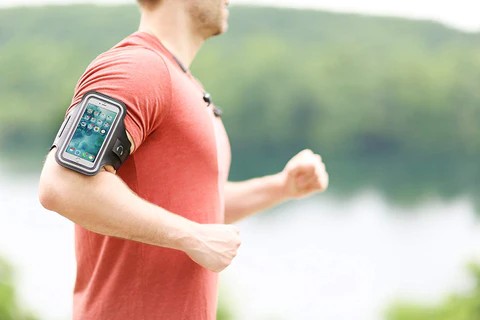
Guide to Power Walking With Weights
Now that all the theory is out of the way, let's get to the fun stuff!
Start small, by getting your body used to carrying weights. Get up to speed with two 1.5 kg (3.3 lb) weights and go from there. Don't rush into heavier weights before you're ready: you'll be surprised at how much effort it takes just to hold something in your hands for extended period of time, especially for a beginner.
Take your time power walking with your first weights. After all, this is just the beginning, and the more enjoyable the experience, the higher the chances that you'll stick with the new routine!
Start by simply walking with your new weights. Note how in the following example stride length is similar to normal walking, and arms aren't flexed/extended too much. It is literally "walking with weights".
After walking with weights for a some time, you'll get a feeling that you're ready for the real deal. And all you need to level-up from walking with weights to Power Walking With Weights is:
- walk slower compared to normal power walking
- flex and extend arms further
- (optionally) increase stride length
The first point is especially important, since if you walk too quickly, instead of moving your arms in a controlled manner you'll end up flinging them back and forth to keep up, which is something you should never do. More on that later. Note that the primary focus of power walking with weights is the upper body and the glutes. Therefore, compared to the amount of arm flexion/extension, stride length is less important.
Here's what "standard" PWWW could look like:
To control the intensity, you could try increasing the amount of arm flexion even further by raising the weights up to or above your shoulders for short periods at a time. No need to keep stressing yourself any harder than you have to. Don't let working out turn into a chore:
Arm Movement: Deliberate and Controlled
A vitally important topic to discuss before going any further.
When you walk normally without any additional weights in your hands, you don't really think about your arm movements. The arms literally hang and swing back and forth to help maintain balance. But as soon as held weights come into play, it's no longer a cake-walk: almost all muscles of the the upper and lower body get engaged to to compensate for the increased rotational momentum introduced by the added lateral weight.
And here is where some of the most wide-spread injuries happen: in the shoulder joint.
The shoulder has the greatest range of motion of all skeleton joints. In fact, the shoulder consists of 4 (!) joints. All of those are connected with ligaments and supported by muscles.
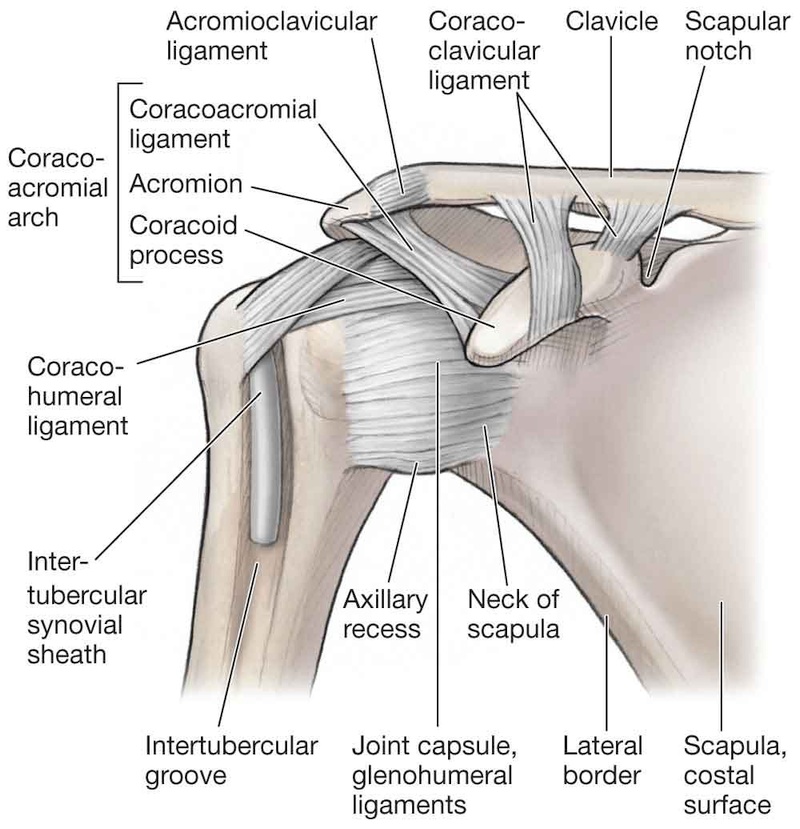
The problem arises when the former is overstressed while the latter is overly relaxed. Great care should be taken when pulling on the shoulder joint, which is what happens when hand weights get involved.
I'll elaborate with another, better-known example:
Pull-Ups and Shoulder Safety
Maintaining control of muscle tension is actually a prerequisite for performing pull-ups safely: one should never completely relax the shoulder muscles and allow oneself to hang "like a meat bag". If you let your body hang by just holding the bar with your hands, the arm and shoulder muscles will stretch to their maximum length. When this happens, tremendous stress is placed on the actual arm joints and ligaments, which can lead to shoulder impingement, rotator cuff tendinitis, shoulder bursitis, or rotator cuff tears.
Again, always remember how insanely complicated (and inherently vulnerable) the shoulder joint is! Look closely at how much movement happens when you raise (abduct/adduct) the arms sideways (source):
You can easily see that relying solely on ligaments to hold the skeleton together when a pulling stress is applied to the joint is a terrible idea. That's what muscles are for!
Therefore, note how in the example below, on the left, the man doing pull-ups is simply hanging on the bar. Whereas on the right the upper-body muscles are engaged to spread the shoulders apart and re-distribute the stress onto the muscles.
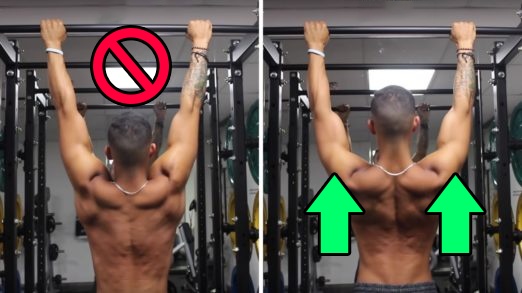
What About Walking With Weights?
When walking, be it weighted or not, the joint movement (called flexion/extension) is slightly different from abduction/adduction as can be seen in this clip (source):
Still, you can see how many components make up shoulder movement in this case as well. Therefore when walking with weights you should never relax your shoulder muscles and "fling" or swing your arms freely back and forth!
The movement of the arms must be controlled and deliberate!
Like so:
Power Walking With Weights can and should be safe as long as you understand the importance of controlled arm movement and never let yourself "cheat" by flinging those weights around. If you did that, you'd only be lying to yourself.
OK, with this important clarification out of the way, lets continue.
Add Some Variation
Performing the same motion with your arms for some time while holding weights can become uncomfortable due to accumulated muscle stiffness caused by repetitive motion. To avoid this and make the workout more exciting, try introducing variations to arm movements.
Arm bending will help improve the blood flow in biceps and triceps:
Rotating the hand and the arm will apply more stress on the shoulders, helping shape them up over time:
Classic bicep curls will help recover the arms quicker:
Whereas overhead triceps curls help focus more on the triceps:
Try to come up with your own variations. Keep it fresh.
Challenge Yourself With Power Sprints!
As you become more confident in your ability to power walk, you may want to take it a step further by introducing an additional challenge. Adding weights would be a somewhat drastic change as it would affect the whole dynamic of the workout. But there's something you can easily do to temporarily increase the intensity and "benchmark" yourself against increased challenge: sprints. Or "Power Sprints" as I prefer calling them.
Think of them as short (!) bursts of running with the same weights in your hands. Depending on your ability, you can try different arm and weight positions. A more traditional one with lateral arm movement:
Or, by varying the location of the weights, you can change both the center of gravity, as well as the muscles engaged in the movement. Stabilizing arms and placing them closer to the torso makes it easier to maintain balance, for instance:
If you feel bold and adventurous, you may decide to introduce knee bends, ending up with something resembling a traditional aerobic exercise, not even a sprint. Keep in mind that this does increase stress on the knees, so apply caution and don't sink too low with each step.
Keep experimenting and remember that challenge is good in moderation. Challenge yourself, but be careful not to overdo it, as power walking is all about sustained effort over a long period of time. If you continue to overexert yourself, you may become disinterested in power walking, as it will become associated with extreme stress, rather than exciting walking. Don't let that happen!
Tips And Tricks
Suck That Belly In and Walk Straight!
A very important benefit of power walking is the added stress on the abs and obliques. Strengthening the abdominal muscles is especially beneficial because they help keep the belly from bulging out over time. Maintaining a "flat tummy" is not just about avoiding fat accumulation. Muscle tone and tension play an important role in keeping the organs in place.

When power walking, make sure to stand straight, don't slouch, and keep your abs flexed. Over time, you'll teach your body to maintain that flex mostly unconsciously, which will go a long way toward helping you maintain a flatter tummy for much longer, possibly your entire life. At least, that's something I am keeping an eye on, and plan to refrain my waist from losing shape over time by keeping those muscles in check.
Walk In Harmony, Let Go of Technology
From the very first walk, I made a conscious decision to avoid listening to music during my powerwalks. Instead, I focus on the movement and the sense of discovery that comes from walking new paths. This approach is also known as "walking meditation". Constant artificial stimulation can make your brain unable to enjoy an activity without its constant presence.
Apparently, even Tik Tok had a recent trend, where influencers were promoting "silent walking". Aside from a stupid trend name, the idea is similar: avoid distractions and focus on an activity at hand. A surprisingly useful trend, which is exceptionally rare to come from this platform.
Get Into the Rhythm!
Power Walking is a flexible workout. You can choose to either challenge yourself, or try to reach and maintain a "Zone 2/Fat burning zone" rhythm for maximum weight loss. It's up to you to choose the intensity of the workout. You can learn about the "zones" from this vid:
Don't Rock'n'Roll
Added weights increase rotational moment when arms are flexed/extended back and forth. Make sure to maintain balance and never allow yourself to tilt or lean side to side.
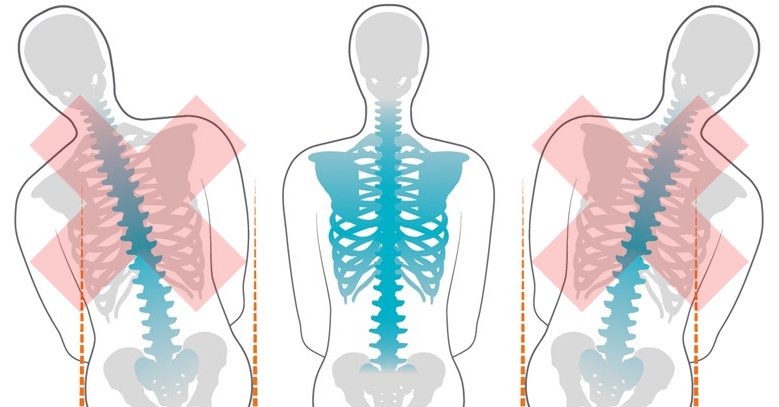
The very idea of Power Walking With Weights is to teach your body better balance via a medium-intensity form of long-term endurance training. If you allow your body to tilt and lean, you will greatly reduce the effectiveness of the workout, as well as set yourself up for a potential injury.
Develop Good Eating Habits
Every workout causes cell breakdown and regeneration. In order for these processes to occur successfully en masse, the body needs a variety of nutrients and electrolytes. It's your job to supply it with the right fuel to cover all the bases.
As I previously stated in another post on fitness, I'm neither a dietician, nor a nutritionist. Therefore, I can only use my own personal experience to judge which foods should be included in a healthy diet. In many cases, advising someone on dieting is futile, since confirmation bias is a thing. Healthy diets usually consist of whole foods, and if someone spent lots of time consuming processed or ultra-processed foods, convincing them against their habits is exceptionally hard, and should be left for a nutritional professional. Whilst people who are already eating healthy will just… continue to do just that and are already aware what foods they should be looking for. That said, here are some suggestions on foods to eat and not to eat, based on my personal experience and general common sense:
Whole foods to eat:
- Fish, Cod liver oil
- Leafy greens and vegetables
- Grass-fed meats
- Heathy fats and oils (virgin olive and coconut, butter)
- Cheese and eggs, sour cream, cream cheese
A second opinion, if you're interested:
Avoid:
- Sugar and sugary foods and drinks, especially "energy" drinks. Sugar is 50/50 glucose and fructose. The top combination to get diabetes and fatty liver disease at record pace
- Bread, grains and cereals. Or pretty much any "complex" carbohydrates, because those mostly consist of starches, which are long chains of glucose molecules. So they're not that "complex" as soon as they get broken down in the gut and end up as insulin-spiking glucose, similar to sugar
- Any corn and soy products. Feel free to do your own research to agree or disagree
- Any fast food. Any fast food. Any. Fast. Food. Period.
- Chicken (look up "chicken and antibiotics" to find out why), including chicken-based foods from fast food chains. Alas, chicken is no longer chicken in many cases, so it's safer to just avoid consuming it
- Bonus: artificial sweeteners (aspartame, saccharin, sucralose etc.). Aside from the fact that some sweeteners are literally side-products of pesticides, the sensation of sweetness on the tongue kick-starts appropriate chemical processes in the body, since in nature sweet stuff is usually energy- and carb-rich. The longer you consume foods with artificial sweeteners or keep adding them to your food and drinks, the higher the chance that all of those bodily mechanisms get jeopardized beyond recovery. If you have a sweet tooth, try using stevia as a sweetener. At least it's a real plant and not a cheap byproduct of some random chemical reaction in a large factory
A second opinion, if you're interested:
Avoid Putting Weights On Lower Legs And Ankles
This has been mentioned before, but deserves another round.
In his book, Steve Reeves talks about how weights can be distributed to different areas of the body: arms, torso, and legs. And while I can agree that placing weights on the arms and torso makes sense, I would strongly disagree and argue against placing additional weights on the lower body, especially around the ankles. Although I'm not an expert or a doctor, I spent 5 years of my life training for ice sprint skating. And in a long list of lower-body aerobic exercises designed to strengthen legs and improve endurance, there wasn't a single one that placed any kind of weight anywhere below the knee. The reasoning was that such an appendage would throw off balance, while not adding much to the effectiveness of a movement set. All in all, adding weights around the ankles will not make your legs stronger, proper strength training will.
Get Some Nice Sleep!
I can't stress enough how important sleep is for both physical and mental recovery. Lots of people underestimate the importance of sleep and choose to go to bed as late as possible in order to prolong what they perceive to be more "useful" periods of activity, viewing sleep as more of an inconvenience than an essential part of life.
No matter what your schedule looks like, if you decide to take up power walking, please consider sleeping at least 7 hours a day to give both your body and your mind as much rest as possible: the former because, duh, muscles, and the latter — to make the most of newly gained experience, since during sleep your brain analyzes and improves on what you've learned during the day. Remember how I mentioned how walking with weights changes the way you experience "normal" walking? Well, a key part of that is giving your brain enough time to get used to it. I promise that after just a few weeks of walking with weights, you'll discover a whole new enjoyment in walking. Just normal walking, no weights required.
To save time I'll reference a video on the topic. Please do find the time to watch it:
How Is Power Walking Different From 8 Minute Exercises? Are Those Still Viable?
"The 8 Minute Body system" by Jaime Brenkus should remain a viable series for those who are looking to improve overall fitness of their arms, abs and legs, whilst not necessarily looking to "bulk up". This is due to the fact that those are primarily aerobic-style exercises designed to make you move and breathe rhythmically.

These exercises are great for compensating for a sedentary lifestyle or for people with certain traumas or disabilities, since they are targeting specific body areas and are overall light on the body (unless you want to challenge yourself by adding weights or prolonging the duration of each move-set). And of course, they can be performed in the comfort of one's home, in a room or on a training mat.
Speaking of which...
With traditional power walking, which requires you to either get out of your home, or at least get on a treadmill, trying to power walk in place would be… awkward and largely inefficient. But when you introduce weights, the focus is less on walking and more on the upper body balancing and movement. So you can absolutely practice PWWW at home by replacing the walking part with gentle knee bends. It's something I do now instead of "The 8 Minute Body System" exercises.
Therefore, I would think of power walking with weights as a strength-oriented replacement for "The 8 Minute Body System":
- it stimulates most of the muscles of the body;
- is a fairly gentle, trauma-free and highly flexible exercise;
- can actually help build muscle over time as you increase the weight carried.
I would advise anyone familiar with "The 8 Minute Body system" to at least give power walking a try, and decide whether it's something worthy of their time.
Results
Below, as of September, 2023. Of course, I didn't just get into this shape by power walking with weights for three months, but rather achieved it through previous fitness efforts and focused on PWWW as a means to maintain and improve the results. Comparatively though, I observed some bulking on the arms and the lats, which is solely the result of regular Power Walking With Weights:

Summary of all notable effects, which I observed in these three months:
- Wider lats (Latissimus Dorsi muscles or "upper back"). The additional stress on the torso and the need to consciously maintain balance due to a greater rotational moment helps to increase the volume of this area to compensate and avoid swinging and twisting with each step. A stronger back is always welcome and will be especially appreciated as you get older.
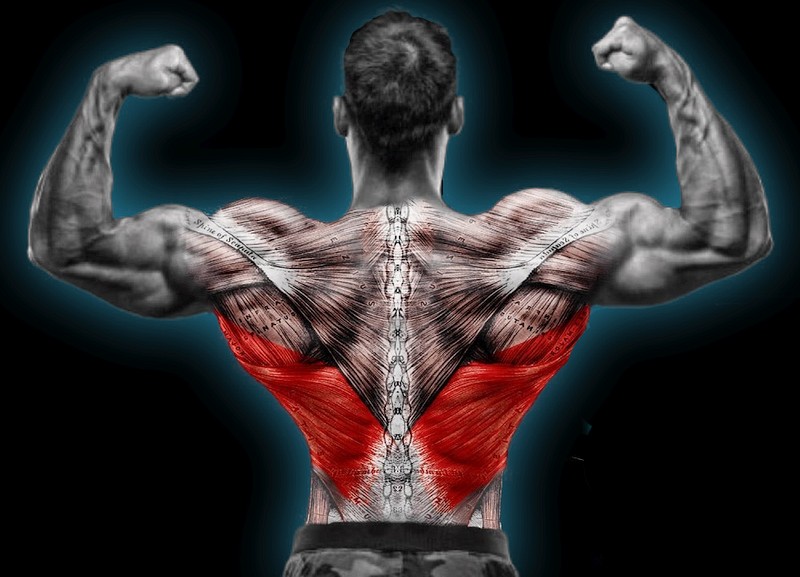
- Flatter stomach. Sucking the belly in during walks tones up both rectus abdominis and transversus abdominis. The latter is a muscle that gets very little attention in our everyday lives, where most of us walk or sit with relaxed abs, which often attributes to the bad posture look. "Skinny With Belly Fat" is another unsightly image that comes to mind. So once again — don't let up on your posture, and flatten your abs when you power walk!

- Normal walking feels like walking on air! A totally expected outcome: if you condition your body to be able to compensate for increased stress on the upped body, removing those weights will make it into a proverbial "cakewalk". Furthermore, in my case, the fact that walking became so effortless made me want to walk: anytime, anywhere for any reason, instead of driving, or howling a taxi.
- Improved overall body stability. Stronger core muscles mean better body control. You can feel it just by sitting at your desk, as you will notice how much easier it is to sit up straight for long periods of time without experiencing back pain or any other kind of discomfort. In fact, slouching is now more difficult for me than sitting up straight! Maintaining proper posture while sitting uses many of the same muscles that get worked during power walking.
- Higher endurance. Obviously, carrying extra weight for prolonged periods of time at a moderate intensity and at elevated heart rate helps the body adapt to harsher conditions. As you continue your journey into the world of Power Walking With Weights, you'll notice how much the newly developed endurance adds to the overall feeling of "always being prepared". On top of that, regular training ensures that a wide range of muscles get their fair share of stimulation, preventing the dreaded soreness that usually occurs the day after a workout and can last for several days.
- Better mental health. Although highly subjective, I'd say "re-discovering the joys of walking" via spending more time outside, whilst also expecting (and achieving!) health and strength improvements, is quite an uplifting combo.
- A boost to self-confidence. When I shared my power walking experience with a good friend, his first response was: "I'd like to try it, but it looks silly!" This (somewhat expected) reaction actually helped me realize something: even though I'm not a particularly self-conscious type of guy and don't have any major self-esteem issues, I did feel a little self-conscious at first power walking through the streets on my way to the woods. I usually do my powerwalks early in the morning, around 6-7am, to avoid the daytime heat. Since it's the crack of dawn, I walk through mostly empty streets and parks. Still, the streets aren't completely empty at this time, and I regularly get curious looks. But as time went on, I noticed how little I cared about random onlookers. This also helped me focus more on the workout itself. And then one day, about 2 months into power walking, I decided to go for a new distance record and took a different path right in the middle of the usual route... Straight through the city streets! Again, it was pretty early in the morning and they weren't too crowded, but I got a huge boost of confidence that I hadn't felt in a long time.
That's It, Folks!
Power Walking With Weights is a fitness workout that somewhat blurs the line between aerobic and a strength training, ending up as a sweet spot between the two. Usually in a gym you want to target specific muscle groups or focus solely on aerobics, but that shouldn't diminish the value of general strengthening exercises like power walking. The goal of these is to help maintain a certain level of fitness when practiced regularly. And this is where Power Walking With Weights shines: it allows you to quickly reach your optimal "walking potential" while adding a little more muscle mass in all the right places to increase your overall movement capacity. This should improve your quality of life and help mitigate potential health problems associated with many of us who neglect certain muscles in our (often sedentary) daily lives. So, please, do try power walking, I'm positive you'll love it so much, you'll turn it into a regular workout...
… and most importantly…